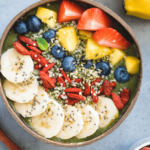Dive into a world of creamy, dreamy delights with our guide to crafting delicious flexitarian ice cream at home! Imagine the vibrant swirls of berry-infused vegan ice cream, the rich texture of Greek yogurt-based creations, or the surprising silkiness of tofu-enhanced masterpieces. This isn’t just about deliciousness; it’s about exploring the exciting intersection of flexible eating and homemade indulgence, opening up a world of flavor possibilities while catering to various dietary needs and preferences. Prepare to tantalize your taste buds and expand your culinary horizons with recipes that are as adaptable as they are satisfying.
From understanding the core principles of flexitarian eating – a balanced approach incorporating both plant-based and animal-derived ingredients – to mastering advanced techniques like manipulating milk alternatives and sweeteners, this guide provides a comprehensive journey. We’ll explore the historical context of vegetarian and vegan ice cream, laying the foundation for your creative explorations. Each recipe, meticulously detailed with nutritional information and step-by-step instructions, will empower you to create stunning, flavorful ice creams tailored to your preferences.
Basic Flexitarian Ice Cream Recipes
These recipes offer delicious and adaptable ice cream options catering to various dietary preferences, showcasing the versatility of flexitarian eating. Each recipe highlights simple techniques and readily available ingredients, resulting in creamy, flavorful ice cream that’s perfect for any occasion. Nutritional information is approximate and may vary based on specific ingredients used.
Vegan Mango Coconut Ice Cream
This vibrant and refreshing ice cream is completely plant-based, offering a tropical escape in every spoonful. The creamy texture comes from the coconut milk, while the mango provides a naturally sweet and tangy flavor.
| Ingredients | Instructions | Notes | Nutritional Information (per serving, approximate) |
|---|---|---|---|
| 1 (13.5 ounce) can full-fat coconut milk, refrigerated overnight | 1. Scoop out the solidified coconut cream from the can, leaving the watery liquid behind. | For a smoother texture, strain the coconut cream through a fine-mesh sieve. | Calories: 250, Fat: 20g, Carbohydrates: 25g, Protein: 3g |
| 1 ½ cups frozen mango chunks | 2. Add the coconut cream and mango chunks to a food processor or high-powered blender. | Use ripe, sweet mangoes for the best flavor. | |
| ¼ cup maple syrup (or to taste) | 3. Blend until completely smooth and creamy. | Adjust the maple syrup according to your preference for sweetness. | |
| 1 teaspoon lime juice | 4. Transfer the mixture to a freezer-safe container and freeze for at least 4 hours, or until solid. | For a softer texture, let the ice cream sit at room temperature for a few minutes before serving. | |
| Pinch of salt | 5. Enjoy! | Adding a pinch of salt enhances the sweetness of the mango. |
Vegetarian Mint Chocolate Chip Ice Cream
This classic combination gets a vegetarian twist with the addition of rich, creamy coconut cream. The cool mint and dark chocolate chips create a delightful contrast of flavors and textures.
| Ingredients | Instructions | Notes | Nutritional Information (per serving, approximate) |
|---|---|---|---|
| 1 (13.5 ounce) can full-fat coconut milk, refrigerated overnight | 1. Scoop out the solidified coconut cream from the can, leaving the watery liquid behind. | Using full-fat coconut milk is crucial for a creamy texture. | Calories: 280, Fat: 22g, Carbohydrates: 20g, Protein: 4g |
| 1 cup heavy cream | 2. In a large bowl, whisk together the coconut cream and heavy cream until smooth. | Ensure the coconut cream is well-chilled for optimal whipping. | |
| ½ cup granulated sugar | 3. Gradually add the sugar, whisking until fully dissolved. | Adjust sugar amount based on your preferred sweetness. | |
| 2 tablespoons mint extract | 4. Stir in the mint extract. | Start with less extract and add more to taste, as mint extract can be potent. | |
| 1 cup dark chocolate chips | 5. Gently fold in the chocolate chips. | Use high-quality dark chocolate chips for the best flavor. | |
| 6. Transfer the mixture to a freezer-safe container and freeze for at least 4 hours, or until solid. | For easier scooping, let the ice cream sit at room temperature for a few minutes before serving. |
Greek Yogurt Berry Ice Cream
This recipe utilizes Greek yogurt as a flexible protein source, offering a tangy and refreshing ice cream packed with antioxidants from the berries. The yogurt adds a creamy texture and a boost of protein.
| Ingredients | Instructions | Notes | Nutritional Information (per serving, approximate) |
|---|---|---|---|
| 2 cups plain Greek yogurt (full-fat recommended) | 1. In a food processor or blender, combine the Greek yogurt and berries. | Use a variety of berries for a more complex flavor profile. | Calories: 180, Fat: 8g, Carbohydrates: 20g, Protein: 10g |
| 2 cups mixed frozen berries (strawberries, blueberries, raspberries) | 2. Blend until smooth. | If the mixture is too thick, add a tablespoon of milk or water at a time until desired consistency is reached. | |
| ½ cup honey or maple syrup (or to taste) | 3. Add the sweetener and blend again until well combined. | Adjust the sweetener based on the sweetness of the berries and your preference. | |
| 1 teaspoon vanilla extract | 4. Stir in the vanilla extract. | Pure vanilla extract is recommended for the best flavor. | |
| 5. Transfer the mixture to a freezer-safe container and freeze for at least 4 hours, or until solid. | Allow the ice cream to soften slightly before serving for optimal scooping. |
Advanced Flexitarian Ice Cream Techniques

Mastering the art of flexitarian ice cream extends beyond basic recipes. This section delves into advanced techniques to elevate your homemade creations, focusing on milk alternatives, sweetener variations, and innovative flavor combinations to achieve diverse textures and taste profiles. The possibilities are as limitless as your imagination.
Exploring diverse milk alternatives significantly impacts the final product’s texture and flavor. Each milk type offers unique characteristics that contribute to the overall sensory experience.
Milk Alternatives and Their Impact on Ice Cream Texture
The choice of milk significantly influences the final ice cream’s texture and mouthfeel. Almond milk, for instance, lends a subtly nutty flavor and a lighter, less dense texture compared to dairy milk. Soy milk contributes a slightly beany note and a creamy consistency, while oat milk provides a naturally sweet and subtly creamy base, often resulting in a smoother, less icy texture. The fat content of each milk type plays a crucial role; higher fat content generally results in richer, creamier ice cream, while lower fat content might lead to a slightly icier result. Careful consideration of these factors is key to achieving the desired texture. For example, using full-fat coconut milk can create a luxuriously rich and creamy ice cream, while using unsweetened almond milk might require the addition of extra fat, such as coconut cream, to achieve a similar consistency.
Sweetener Selection and Flavor Pairing
The sweetness level and flavor nuances of your ice cream are heavily influenced by your sweetener choice. Maple syrup introduces a complex, warm sweetness with hints of caramel and woodsy notes, perfectly complementing flavors like cinnamon or pecan. Agave nectar provides a milder, slightly floral sweetness, ideal for fruit-based ice creams or those with delicate floral extracts. Dates, when blended into a smooth paste, offer a natural sweetness with a caramel-like depth and a subtle date flavor that works well with chocolate or spices. The choice of sweetener also impacts the final texture; some sweeteners, like maple syrup, can contribute to a slightly denser texture compared to others.
A Unique Flavor Combination: Black Sesame and Toasted Coconut Ice Cream
This recipe showcases the potential of unusual ingredients to create a surprisingly harmonious and complex flavor profile. Black sesame seeds offer a rich, nutty, and slightly bitter flavor with a subtly earthy undertone. Toasted coconut adds a sweet, tropical note and a pleasant textural contrast. The combination results in a sophisticated ice cream with a depth of flavor and a delightful textural interplay.
Recipe: Blend 1 cup full-fat coconut milk, ½ cup black sesame paste, ¼ cup toasted coconut flakes, ¼ cup agave nectar, and a pinch of sea salt until smooth. Churn according to your ice cream maker’s instructions. Garnish with extra toasted coconut flakes before serving.
Achieving Desired Ice Cream Textures
Controlling the texture of your ice cream involves careful attention to several factors. A creamy texture is achieved through a high fat content in the base (using full-fat coconut milk, cream, or adding additional fat sources like avocado), and proper churning to incorporate enough air. An icy texture can result from a low fat content or insufficient churning, while a smooth texture requires careful blending of ingredients to eliminate any lumps or ice crystals. Over-churning can also lead to an overly airy, less dense texture. Experimentation is key to finding the perfect balance.
Flavor Variations and Inspirations
Unlocking the world of flexitarian ice cream means exploring a vibrant spectrum of flavors, far beyond the traditional dairy-centric options. The beauty lies in the adaptability of the base recipe, allowing for creative combinations that highlight the natural sweetness and unique textures of fruits, vegetables, and plant-based milks. This section delves into exciting flavor profiles and provides guidance on crafting your own seasonal masterpieces.
The possibilities are endless when it comes to creating unique and delicious flexitarian ice cream flavors. By understanding how different ingredients interact, you can develop exciting new combinations that are both satisfying and healthy.
Unique Flexitarian Ice Cream Flavor Combinations
These five unique flavor combinations showcase the versatility of flexitarian ice cream, balancing sweetness, texture, and subtle savory notes. Each combination offers a distinct flavor profile, appealing to a wide range of palates.
- Roasted Sweet Potato & Maple Pecan: Imagine a creamy base infused with the earthy sweetness of roasted sweet potatoes, complemented by the rich, nutty flavor of maple-glazed pecans. The warm spices of the sweet potato blend beautifully with the maple’s sweetness, creating a comforting and sophisticated dessert. The pecans add a delightful textural contrast.
- Avocado Chocolate Mint: The richness of avocado forms a surprisingly decadent base, providing a creamy texture without the heaviness of traditional dairy. The addition of dark chocolate chips lends a deep, intense chocolate flavor, balanced by the refreshing coolness of fresh mint. This combination is unexpectedly delightful.
- Black Sesame & Coconut with Toasted Rice: A subtly nutty and slightly earthy flavor profile. The black sesame paste adds a deep, almost smoky note, which pairs beautifully with the creamy sweetness of coconut milk. Toasted rice crisps provide a satisfying crunch, adding textural complexity.
- Carrot Cake Spice with Cashews: This flavor profile captures the essence of a classic carrot cake in frozen form. The sweetness of carrots blends perfectly with warming spices like cinnamon, nutmeg, and ginger. Cashews add a creamy texture and nutty flavor, enhancing the overall richness.
- Beetroot & Raspberry Swirl: A vibrant and unexpected combination. The earthy sweetness of roasted beetroot provides a unique base, while the tartness of raspberries adds a refreshing counterpoint. The contrasting colors create a visually stunning swirl effect.
Creating Custom Flavors with Seasonal Produce
Harnessing the bounty of seasonal fruits and vegetables is key to creating truly unique and flavorful flexitarian ice cream. The peak season of an ingredient often translates to its most intense flavor and optimal texture. For example, using ripe summer berries results in a brighter, more intense flavor than berries purchased out of season.
The process involves selecting seasonal produce at its peak ripeness, preparing it (e.g., roasting, pureeing, or finely chopping), and incorporating it into your chosen ice cream base. Consider the natural sweetness of the ingredient and adjust the amount of added sweetener accordingly. Experimentation is encouraged; each season offers a unique palette of flavors to explore.
Balancing Sweet and Savory Flavors
The art of flexitarian ice cream lies in achieving a harmonious balance between sweet and savory notes. This is where the culinary creativity truly shines. Subtle savory elements can elevate a dessert from ordinary to extraordinary.
For instance, a hint of sea salt can enhance the sweetness of a fruit-based ice cream, highlighting the natural sugars. Similarly, incorporating roasted vegetables like butternut squash or sweet potato can introduce subtle earthy notes that complement sweeter elements like maple syrup or dates. The key is to use savory ingredients sparingly, allowing the sweetness to remain the dominant flavor profile, but with a complex and intriguing depth.
A successful balance involves understanding the inherent sweetness of your base and chosen ingredients, and then adding complementary savory elements in measured quantities to enhance, not overpower, the overall flavor.
Crafting homemade flexitarian ice cream isn’t just about following recipes; it’s about embracing a culinary adventure. The journey from simple vegan delights to complex, multi-layered creations allows for boundless creativity and personalization. With the techniques and inspiration provided here, you’ll be empowered to experiment with seasonal fruits, unexpected flavor pairings, and stunning presentations. Whether you’re serving classic scoops, elegant parfaits, or inventive ice cream sandwiches, each creation becomes a testament to your culinary skill and a delightful treat for you and your loved ones. So, embrace the flexibility, unleash your creativity, and savor the delicious rewards of homemade flexitarian ice cream.
Questions and Answers
Can I use frozen fruit in my flexitarian ice cream?
Absolutely! Frozen fruit works wonderfully, often eliminating the need for added ice. Just ensure it’s chopped or pureed for a smooth texture.
How long does homemade flexitarian ice cream last?
Homemade ice cream, stored in an airtight container in the freezer, typically lasts for 2-3 weeks. However, quality may diminish over time.
What are some good substitutes for dairy milk?
Excellent alternatives include almond milk, soy milk, oat milk, coconut milk (full-fat for creaminess), and cashew milk.
Can I make flexitarian ice cream without an ice cream maker?
Yes! While an ice cream maker produces the smoothest results, you can achieve a delicious, albeit slightly icier, texture by using a freezer-safe container and manually churning the mixture every 30-60 minutes.


